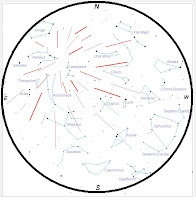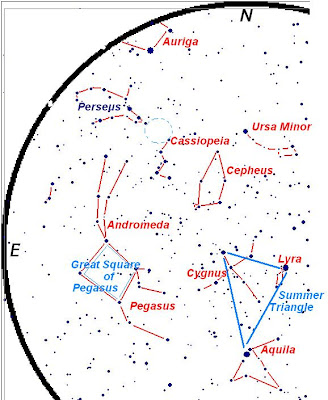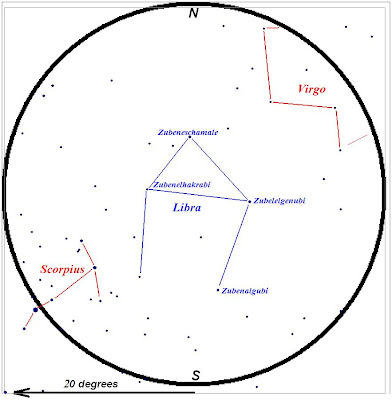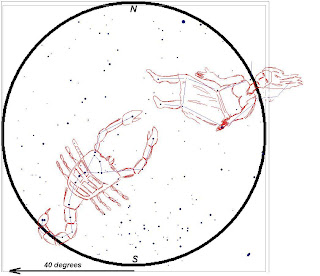.....The name of this constellation is more widely recognizable through Harry Potter than through astronomy awareness, but that might not be unfair.
,,,,,The constellation Draco the dragon is a northern circumpolar constellation. For much of the northern hemisphere, Draco is above the horizon for all of the year. North of the Mason-Dixon line, Draco is always in the sky, winding part of its length between the DIppers. Well, if this is the case, why is Draco so much less familiar? The short answer is that Draco, while large, has no bright stars. The brightest star in Draco has a visual magnitude of 2.23, or the 69th brightest star in the sky. Draco's primary claim to fame is that Thuban, one of its stars, is periodically the North Star. Thuban's last pass at glory came during the construction of the pyramids (giving us about twenty-two thousand years until its next turn at the pole)
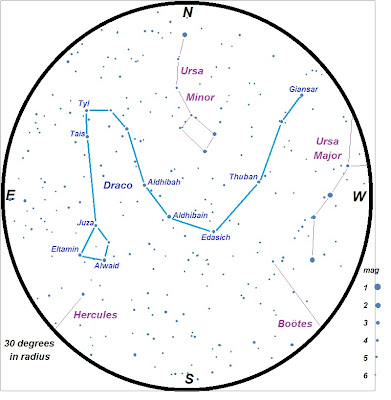
.....Draco is quite a large constellation, filling our starting placement map. No zooming will be necessary. One might note that while Draco has no truly bright stars, its has a number of named stars. This seems strange at first blush, so let's conjecture why this might be...
.....First, when many of our constellations were being named (or at least getting the names that would stick), Draco contained the North Celestial Pole, with the entire sky appearing to rotate around Thuban the way that the sky now appears to rotate around Polaris. This naturally made Draco an important constellation, so its stars were more likely to receive names. But ask yourself this question: Why did stars receive individual names in the first place? Imagine yourself standing outside, looking up at the stars with at least one friend (unless you are actually doing this, in which case I salute you, and hope that your presumably mobile device has a dimming feature). Pick a star. Now, how would describe which star you had picked to your friend? If your star was the brightest in a given area, you might describe it that way, and if it was not, there is an excellent chance that you used that bright star as part of your directions. If we start with a set of named stars, then we can cut out a lot of the uncertainty right from the get-go: "It's that star right below Vega," you might say (if it happened to be that star). Now, if you were looking a Draco, Draco is (a) very large, and (b) low on bright stars. that could lead to a number of stars in Draco getting names, just to have a starting point telling one not terribly bright star from another.
.....Speaking of names, the name Draco is probably more recognizable as Harry Potter's classmate and frequent antagonist from the eponymous series. Readers (as opposed to movie viewers) may have recognized a number of star and constellation names, mostly in the Black and Malfoy families. (What, did an astronomer cut J. K. Rowling off on her way to the coffee shop one day?) Here are the names used, and where in the sky they can be found:
Andromeda Tonks, nee Black, the mother of Nymphadora Tonks: Andromeda is a fall constellation, now visible on the eastern horizon once night has fully fallen.
Alphard Black :The son of Pollux Black and the uncle of Sirius Black
Arcturus Black, patron of Sirius Black: Arcturus is the brightest star in the constellation of
Boötes.
Bellatrix Lestrange, nee Black, major villain: Bellatrix is one of the bright stars that form the winter constellation of Orion. Bellatrix (Latin for "female warrior") is the western shoulder of Orion.
Cassiopeia Black: Cassiopeia is a circumpolar constellation for much of the northern hemisphere, most prominent in the fall sky, appearing as an "M" or a "W", depending on what side of the Mississippi River you're on . (At least around here. :) )
Cygnus Black: Cygnus (aka the northern cross, containing the star Deneb) is a major summer constellation.
Pollux Black: Pollux is a bright star in the winter constellation of Gemini.
Regulus Arcturus Black: Regulus is the brightest star in the constellation of Leo.
Sirius Black: Sirius is the brightest star as seen from Earth (fine, barring the Sun, for the pedants out there), and is located in the winter constellation of Canis Major.
Callidora, Cedrella, Charis, Dorea, Elladora, Hesper, Isla, Lucretia, Marius, Phineas: These are not star names. Ms. Rowling apparently had other ideas, or ran out of star names that she liked. (Oh come on! What about "Microscopium Black", or "Aldhibain Black"? That's a missed opportunity right there!)
.....Draco also takes part in a giant summer man-versus-reptile showdown. As intimated here, and more visible on the August star map, Hercules is stomping in Draco's head, back-to-back with Ophiuchus while Ophiuchus is wrestling with Serpens. Thankfully, the constellations were derived thousands of years before the advent of Freudian analysis.
.....Also, wow, this sould have been much more timely if I had posted it a month ago...

















